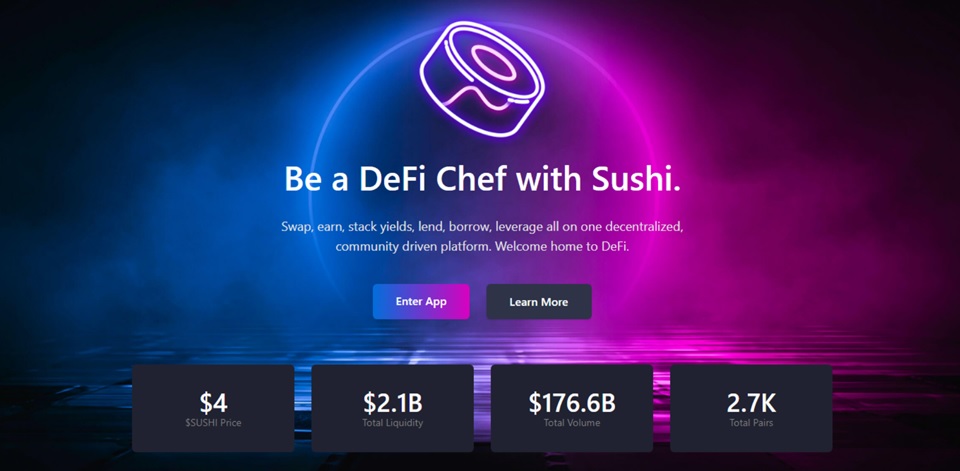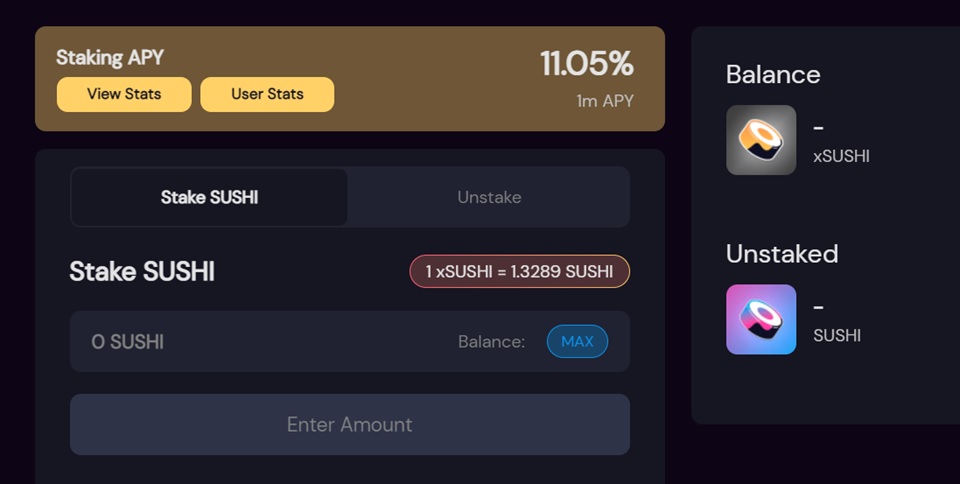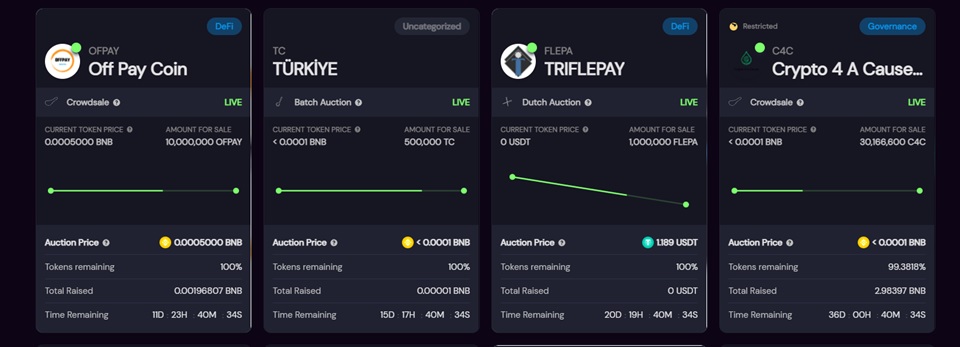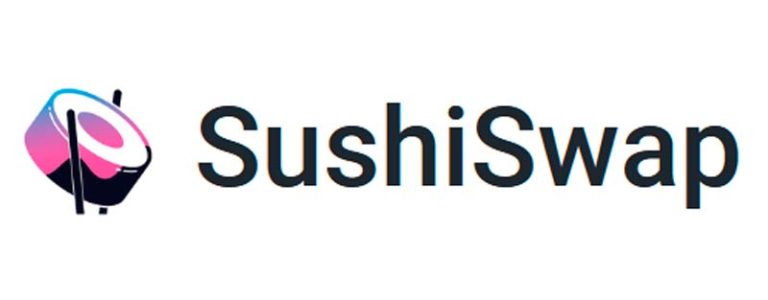We may earn a commission from links on our site, but this doesn’t affect our reviews. Learn more.
Hedge With Crypto is an independent publisher that provides objective and free content. Articles on our site may include links to our partners. If you click on these links, we may earn a commission. However, our editorial content remains unbiased, reflecting our own opinions or the general information available. For more information on our company policies, read the Affiliate Disclosure, Privacy Policy, and Terms & Conditions.
SushiSwap Review
Hedge With Crypto aims to publish information that is factual and accurate as of the date of publication. For specific information about a cryptocurrency exchange or trading platform please visit that provider’s website. This information is general in nature and is for education purposes only. Hedge With Crypto does not provide financial advice nor does it take into account your personal financial situation. We encourage you to seek financial advice from an independent financial advisor where appropriate and make your own enquiries.
TABLE OF CONTENTS
Bottom line:
Traders will go where their currency pairs trade and where the farming yields are highest and SushiSwap might be the better option compared to other DEXs. However, the advantages are mostly outweighed due to the many risks and drawbacks that come with using this controversial DEX. SushiSwap has done very little to set itself apart from other exchanges — while other projects continue to come up with exciting new features, SushiSwap has not kept the pace.
-
Trading Fees:
0.3%
-
Currency:
N/A
-
Country:
Global (USA allowed)
-
Promotion:
None available at this time
How We Rated Sushiswap
| Review Criteria | Hedge With Crypto Rating |
|---|---|
| Features | 4.7 / 5 |
| Supported Fiat and Deposit Methods | 4.6 / 5 |
| Supported Crypto & Trading Pairs | 4.8 / 5 |
| Fees | 4.5 / 5 |
| Ease of Use | 4.1 / 5 |
| Customer support | 2.7 / 5 |
| Security Measures | 4.1 / 5 |
| Mobile App | 2.5 / 5 |
SushiSwap Overview
SushiSwap is a popular crypto DEX that is available on more than 16 blockchain networks. The project was a hard fork of the popular UniswapV2 protocol when it launched in September 2020 on the Ethereum network. The DEX allows users to trade, stake, and earn ERC-20 tokens without the need for a centralized middleman to facilitate the exchange. Traders can use SushiSwap to swap their cryptocurrency for other cryptocurrencies for a small fee. Unlike traditional centralized exchanges, SushiSwap does not require users to create an account or go through a Know Your Customer (KYC) process. Instead, users can trade directly from their ERC-20 compatible wallets. The platform uses a variety of smart contracts to ensure that trades are executed quickly and efficiently.

Alternatively, users can get a portion of the earnings generated from exchange fees by depositing and staking SushiSwap tokens in the platform’s liquidity pools. Anyone can create a liquidity pool for their own token by providing an equal value of any two tokens of their choice. SUSHI is the platform’s token earned through liquidity mining; users also need it to participate in voting on SushiSwap’s governance improvement proposals. Moreover, the community-based governance model is one of the most significant innovations introduced by SushiSwap. The system is designed to encourage and empower users to become more involved with their investments.
What Is A Sushi Token?
On SushiSwap, liquidity is provided by token lenders who are rewarded with SUSHI tokens. In the past, SushiSwap has demonstrated a high potential for profitability, and it still provides experienced high-volume and high-frequency yield farmers with opportunities for moderate to high gains. Sushi is traded on most major and minor crypto exchanges, with the top exchanges being Binance, and Huobi Global.
SushiSwap’s daily volume can be a little tricky because the exchange deploys several different bots that run various smart contract functions. As seen in the image below, at least 70% of the daily volume likely involves trading bots, which may include third-party trader bots as well. Sushi will continue to be rewarded until November 2023, when it will reach the maximum cap of 250 million tokens, of which 10% goes to the Developer fund.

SushiSwap Fees, Funding, & Earnings
For users who are familiar with centralized exchanges, the SushiSwap experience is much different. An account does not need to be created or have an ID verification process. All users need to use SushiSwap exchange is a Web3 wallet, and install it on their web browser as an extension. Before users can use the platform, cryptocurrency will need to be deposited. SushiSwap does not allow users to buy crypto assets with fiat currency via bank account or debit card. Before connecting, most users transfer their funds to a Web3 wallet like MetaMask or 19 other supported wallets. Also, to cover the transaction (gas) fees, users may purchase some ether (ETH) from a centralized exchange like Binance.
All trades are subject to a 0.3% fee levied by the SushiSwap protocol. As participants in a pool, liquidity providers split 0.25%. The SushiSwap Treasury receives the remaining 0.05%. By withdrawing liquidity, users will reclaim the initial tokens staked, along with the rewards they earned in the process.
Review of the Top Features of SushiSwap
SushiSwap offers a range of products and services that all come together on the exchange. The major products include a decentralized exchange, a decentralized lending market, yield instruments an auction platform, an AMM framework and staking derivatives. Sushi's products are designed to be configured in a way that makes it possible for the entire platform to continue to innovate on the collective foundations by design while still maintaining the decentralized governance that is provided by SUSHI token holders. Each of these products will be explored in the sections below.
Sushiswap Liquidity Pools
Sushiswap offers a decentralized yield farming platform that anyone can start by providing initial liquidity to earn rewards. Liquidity pools can be joined by anyone, as well. There is no minimum or maximum amount of liquidity required to participate in any pool. A 0.25% share of all trades on this pair is split between contributors to the pool's liquidity provider. The fees are added to the pool where they accumulate in real-time and can be retrieved by harvesting liquidity. In addition to earning SUSHI and sharing in platform fees with your dormant tokens, Sushiswap users can also earn an additional 0.05% of all trades on the exchange by staking their SUSHI earnings for xSUSHI in the SushiBar.
Stake with SushiBar
SushiSwap’s Sushi Bar is a service for token holders to stake their SUSHI and earn xSUSHI tokens in return. The rewards contract is called once per week to automatically liquidate the pool and convert funds into SUSHI tokens, which are then distributed to xSUSHI token holders. From there, users can decide whether to harvest these earnings or compound them with their current investment.

When users stake SUSHI in the SushiBar, xSUSHI is generated. If users decide to unstake their xSUSHI, they will be refunded all of their staked SUSHI, as well as any additional fees. When users make trades on any of SushiSwap’s platforms, a total of 0.045% of the swap fee is divided up proportionally between all of the xSUSHI holders, and a further 0.005 percent goes to the Sushi Treasury. Because of the way the rewards are generated, xSUSHI will always be worth more than SUSHI, and the price of xSUSHI will increase with the value of SUSHI.
BentoBox
BentoBox is a token vault that contributes to the expansion of the SushiSwap ecosystem and generates returns for any funds deposited within it. It employs low-risk farming techniques such as depositing tokens on Compound for yield lending. Bento funds can also be used for flash loans, which can add passive value to a user's idle capital.
The vault essentially functions as a decentralized “App Store.” Anyone can construct it on top of Bento. SushiSwap users can deposit assets to enable other decentralized applications, such as maximizing token yield through dual token usage. Also, it's designed to reduce transaction fee costs by minimizing the actions required of dApp developers and end users. There is an inbuilt minimal contract factory, so new projects do not always need to create their own.
Kashi Markets Margin Trading
Kashi is a loan and margin trading product that was developed by SushiSwap and built atop the BentoBox platform. Kashi's innovative design enables a new kind of DeFi lending and borrowing platform in which the risks of trading assets within one lending market do not affect the risks of another. This is in contrast to the traditional DeFi money markets, which pose a risk to the entire protocol if they contain high-risk assets.
By supplying investors with the recipes and components required to cook up DeFi smart contracts, this service makes it possible for investors to automate the process of gaining leverage and liquidity on any token. So, lenders can get more potential clients and get higher returns on those assets while avoiding the risk of temporary loss, which is a big problem for DeFi ecosystems.
MISO
The Minimal Initial SushiSwap Offering (MISO) is an open-source collection of smart contracts that were developed to facilitate the process of initiating a new project on the SushiSwap platform. In other words, MISO is a cryptocurrency launchpad on SushiSwap that is analogous to an IDO. However, the website clearly disclaims any responsibility for the quality of the projects that are featured on MISO because the platform is permissionless and anybody may start an auction. Instead, it asks its users to DYOR before investing in any auction.

Using recipes is a fantastic method for getting started with the process of constructing a token launch. Recipes can mix one or more components, allowing users to produce and distribute their own unique MISO. As soon as everything is ready to go, MISO takes over and makes sure everything is operating normally and effectively.
On the contrary, the results up to this point tell a whole different story. MISO has its own dedicated page on the SushiSwap website where it lists all the active, upcoming, and completed auctions on the platform. So far, no project has even come close to successfully reaching its fundraising target goals. There was less than 3 BNB in even the best performing auction to date, and the majority of projects raised nothing at all.
Is SushiSwap Legit?
SushiSwap is a relatively safe cryptocurrency DEX to use, however, it has a long history of issues that have ruined its reputation. These include the SushiSwap vampire attacks that manipulated the liquidity by almost 2B in a few days, and the founders sudden exit when he sold $14 million of Sushi tokens that caused the price to drop sharply.
1. SushiSwap Vampire Attack
SushiSwap originally cloned the UniswapV2 open source code. A significant incentive was initially offered to Uniswap users who switched to SushiSwap. 1,000 SUSHI per Ethereum block (12 seconds) was distributed to the Uniswap liquidity provider across multiple different pools such as SNX-ETH, LEND-ETH, YFI-ETH, and LINK-ETH.
The liquidity attack was a huge success. SushiSwap's locked value surpassed $150 million in a matter of hours. The only problem for SushiSwap was that it was not the only one that benefited. The attempt to drain Uniswap of its liquidity actually ended up attracting more volume to Uniswap, sending volume on the platform skyrocketing in the days leading up to the migration.
The SushiSwap vampire attack on Uniswap’s liquidity pushed the TVL up from around $300M to almost $2B in a matter of days. On top of that, the daily trading volume was ranging between $500M and $1B, and at one point, it overtook Coinbase’s daily volume. It also drove Uniswap to launch its own governance token, UNI. By the end of the month, Uniswap’s TVL rebounded from $500M to a new all-time high of over $2.3 billion in liquidity locked into its protocols.
2. Chef Nomi’s Exit
By September 5, SushiSwap was on its way to locking in over $800 million in staked Uniswap LP tokens awaiting the migration to SUSHI. At the height of it all, Chef Nomi made the sudden decision to drain $14 million from the development pool. Because this was done without any warning, the community was left in the dark to speculate on the chef’s motives. This caused SUSHI's token price to drop 70% within the day, which resulted in a massive backlash from the community.
Days later, Chef Nomi returned all 14 million ETH and apologized to the community for making the unilateral decision to transfer control of SushiSwap to Sam Bankman-Fried, founder of FTX Exchange.
Proposal & Voting Rights
There are also some legitimate concerns about the centralization of distributed power in SushiSwap’s governance program. Furthermore, the same six anonymous team members now control both the Treasury and Ops Multisig wallets. They are the ones who make decisions about the SushiSwap protocol as a whole.ShushiSwap’s website documents the following 6 Twitter handles as the core team members:
- @MatthewLilley
- @0xGasper
- @0xJiro
- @LufyCZ
- @sarangprikh22
- @chillichelli
Many decisions involving SushiSwap’s protocol require at least 3 out of 6 signatures to be approved. These transactions include:
- Use of the devfund wallet
- Adding and removing pools
- Changing pool weights (rewards);
- Changing the SUSHI block reward;
- Approving transactions coming out of the growth fund;
- Overall changes to smart contracts.
Any member of the community is welcome to post a proposal on our forums. If the proposal can gain enough traction, the community will vote to decide the outcome via the SushiSwap channel on the Snapshot.org voting platform.
The Sushiswaps voting metric is weighted in SUSHIPOWAH as follows:
- 1 SUSHI in the SUSHI-ETH pool =2 SUSHIPOWAH
- 1 SUSHI staked in the SushiBar = 1 SUSHIPOWAH
Currently, for a proposal to pass into effect, it must be posted by the CORE and reach a minimum of 5 million SUSHIPOWAH. To be an eligible voter for any proposal on Snapshot, users must have voting rights at the time of the vote. This means that they cannot simply buy SUSHI tokens to vote on an already ongoing proposal. This is a useful safety measure to keep whales and flash loaners from having too much power.
SushiSwap Compared
In comparison to Uniswap, it pays higher fees to liquidity providers (0.3% vs. 0.25% for SushiSwap), but SushiSwap throws in an additional 0.05% split pro rata between all SUSHI holding addresses each day. However, one area where SushiSwap is clearly winning against UniSwap is its multi-chain bridge interoperability. Rather than limiting itself to a single blockchain, SUSHI intertwines many blockchains and protocols. Currently, with the help of LayerZero, users can access and provide liquidity on 16 different blockchains, all from a single web application. When comparing SushiSwap’s and Uniswap’s typical user experiences, Uniswap is the better DEX for most traders, liquidity providers, and yield farmers. Uniswap is simply much smoother, cleaner, and more enjoyable to use. For more information, read our full review on Uniswap.
There are other more user-friendly DEX like PancakeSwap on the BNB Smart Chain network. Compared to SushiSwap and dYdX, PancakeSwap has a wider range of features that are easy for beginners to use and can be both very profitable and surprisingly fun based on our PancakeSwap and dYdX reviews.
Risks and Drawbacks
The AMM protocol that SushiSwap uses has a number of drawbacks, any one of which can result in a significant loss in certain circumstances. The main negatives with using a platform such as SushiSwap include:
- Extreme volatility. One of the most significant issues facing SushiSwap is the extremely high level of volatility, which is directly influenced by the activities of arbitrageurs. As a result, if users use SushiSwap to buy or sell assets, they might end up paying more than the current market value.
- Impermanent loss liquidity farming. SushiSwap liquidity mining can be both extremely risky and extremely profitable. One of the biggest risks with SushiSwap’s liquidity pools is the possibility of impermanent loss vs. gains (in practice, the probability of loss is the highest of the two). If one token’s value has changed relative to the other, it may result in a return of less than what was put in. This is known as “irreversible loss.” The term itself can be misleading, as the losses are permanent once the user withdraws their tokens. Impermanent losses happen due to both high volatility and a non-adjustable constant price. The greater the gap between the given pair, the more significant the impermanent losses become.
